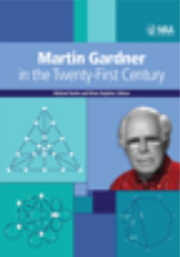Book contents
- Frontmatter
- Preface
- Contents
- I Geometry
- 1 The Asymmetric Propeller
- 2 The Asymmetric Propeller Revisited
- 3 Bracing Regular Polygons As We Race into the Future
- 4 A Platonic Sextet for Strings
- 5 Prince Rupert's Rectangles
- II Number Theory and Graph Theory
- III Flexagons and Catalan Numbers
- IV Making Things Fit
- V Further Puzzles and Games
- VI Cards and Probability
- VII Other Aspects of Martin Gardner
- Index
- About the Editors
4 - A Platonic Sextet for Strings
from I - Geometry
- Frontmatter
- Preface
- Contents
- I Geometry
- 1 The Asymmetric Propeller
- 2 The Asymmetric Propeller Revisited
- 3 Bracing Regular Polygons As We Race into the Future
- 4 A Platonic Sextet for Strings
- 5 Prince Rupert's Rectangles
- II Number Theory and Graph Theory
- III Flexagons and Catalan Numbers
- IV Making Things Fit
- V Further Puzzles and Games
- VI Cards and Probability
- VII Other Aspects of Martin Gardner
- Index
- About the Editors
Summary
Our dance company, the Dr. Schaffer and Mr. Stern Dance Ensemble, began performing mathematical dance shows in 1990. Scott Kim joined us in 1993, and in 1995 Scott, another Bay area dancer Barbara Susco, and I developed a school-age show entitled “Through the Loop, In Search of the Perfect Square,” which included the performance of many string figures.
Martin Gardner wrote several columns on polyhedra and one on traditional string figures, in addition to his many references to magic tricks and puzzles with string [5, Ch. 1], [6, Ch. 17], [7, Ch. 19], [8, Ch. 10], [6, pp. 74-75]. Traditional string figures, made on the hands with a simple loop of string, are found worldwide, particularly associated with ancient cultures [7]. In 1994 our dance company began experimenting with oversize loops carried on stage by dancers, and manipulated to form a variety of string figures. String figure constructions and the associated mathematics make a pleasurable classroom activity that introduces graph theory and polyhedra to geometry, liberal arts, and discrete math students, or as a hands-on activity for workshops and math festivals.
In the process of creating one of our shows, “Through the Loop,” which includes over 20 string figures, we began altering well-known figures, using large loops held by several dancers, or using a sequence of finger manipulations different from the customary methods. Traditional string figures often display shapes or actions reminiscent of the natural world, as indicated by such titles as: Bear Climbing a Tree, the Yam Thief, and Mosquito.
- Type
- Chapter
- Information
- Martin Gardner in the Twenty-First Century , pp. 19 - 24Publisher: Mathematical Association of AmericaPrint publication year: 2012



